Comprehensive Report on Risk Management in International Finance
VerifiedAdded on 2020/05/16
|13
|2287
|80
Report
AI Summary
This report provides a comprehensive overview of risk management in international finance. It begins by analyzing a specific scenario involving currency exchange rates, hedging strategies using forward contracts and put options, and the application of Purchasing Power Parity (PPP). The report then...
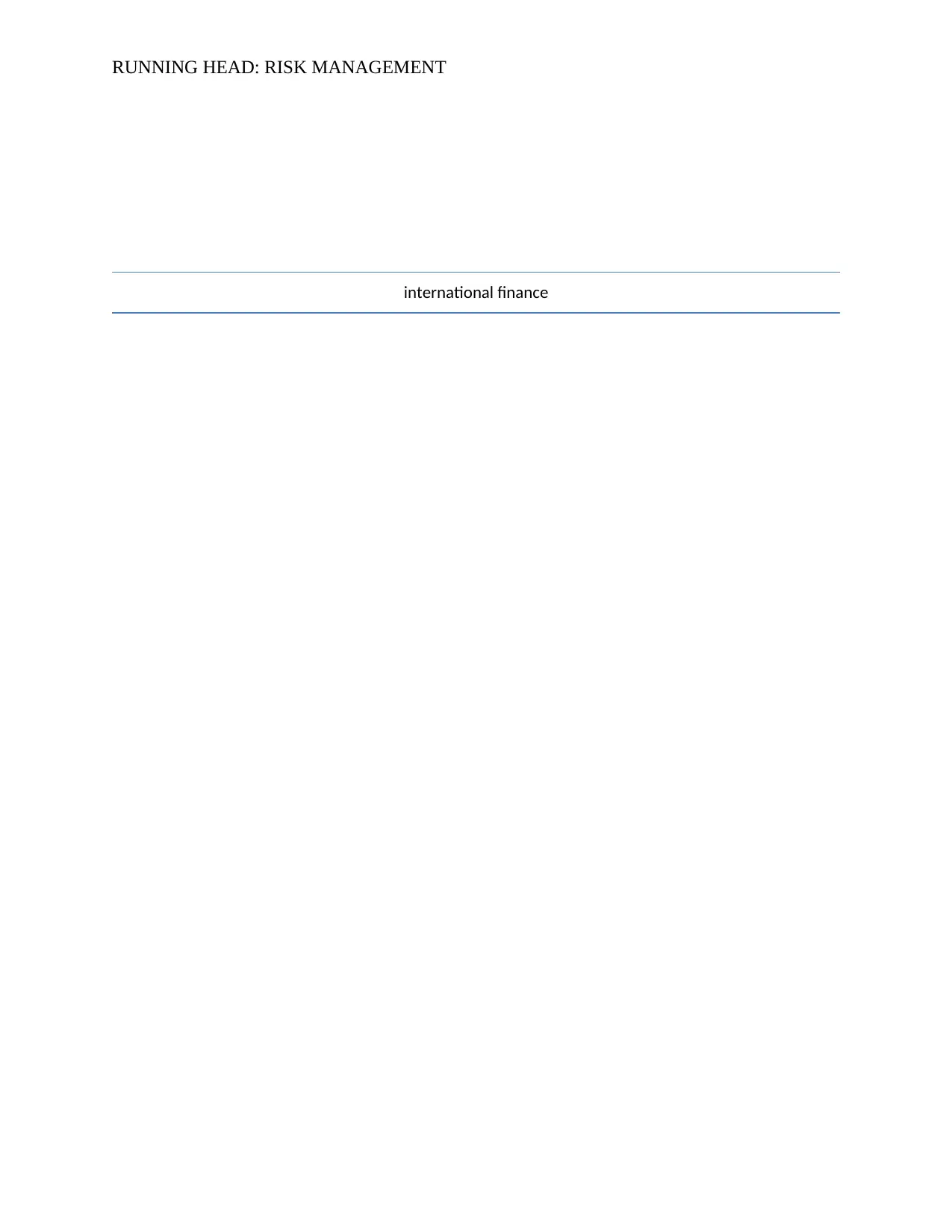
RUNNING HEAD: RISK MANAGEMENT
international finance
international finance
Paraphrase This Document
Need a fresh take? Get an instant paraphrase of this document with our AI Paraphraser

RISK MANAGEMENT 1
1. Given information are as follows:
Domestic Country is Peru (PEN)
Foreign Country is Canada(CAD)
Spot Price = 0.40 PEN/CAD
Put options on sole has 1year expiration period
Exercise Price = 0.45 PEN/CAD
Premium = CAD 0.07 per unit
1million Peruvian Soles
Annual Interest Rates:
Peru = 5%
Canada = 3%
Annual Inflation Rates:
Peru = 3%
Canada = 2%
a) Forward Contract Hedge:
In forward Contract, an exchange rate is quoted today for settlement at a future date.
E (S1) = Exercise Price * No. of units
Taken information from above figures, expected amount of CAD received after one year
using forward contract hedge = 10,00,000 * 0.45 = CAD 4,50,000
b) Purchasing Power Parity (PPP):
Purchasing power parity focuses on ‘inflation-exchange rate’ relationship.
E (S1) = Current Spot rate * expected difference in inflation rates
1. Given information are as follows:
Domestic Country is Peru (PEN)
Foreign Country is Canada(CAD)
Spot Price = 0.40 PEN/CAD
Put options on sole has 1year expiration period
Exercise Price = 0.45 PEN/CAD
Premium = CAD 0.07 per unit
1million Peruvian Soles
Annual Interest Rates:
Peru = 5%
Canada = 3%
Annual Inflation Rates:
Peru = 3%
Canada = 2%
a) Forward Contract Hedge:
In forward Contract, an exchange rate is quoted today for settlement at a future date.
E (S1) = Exercise Price * No. of units
Taken information from above figures, expected amount of CAD received after one year
using forward contract hedge = 10,00,000 * 0.45 = CAD 4,50,000
b) Purchasing Power Parity (PPP):
Purchasing power parity focuses on ‘inflation-exchange rate’ relationship.
E (S1) = Current Spot rate * expected difference in inflation rates
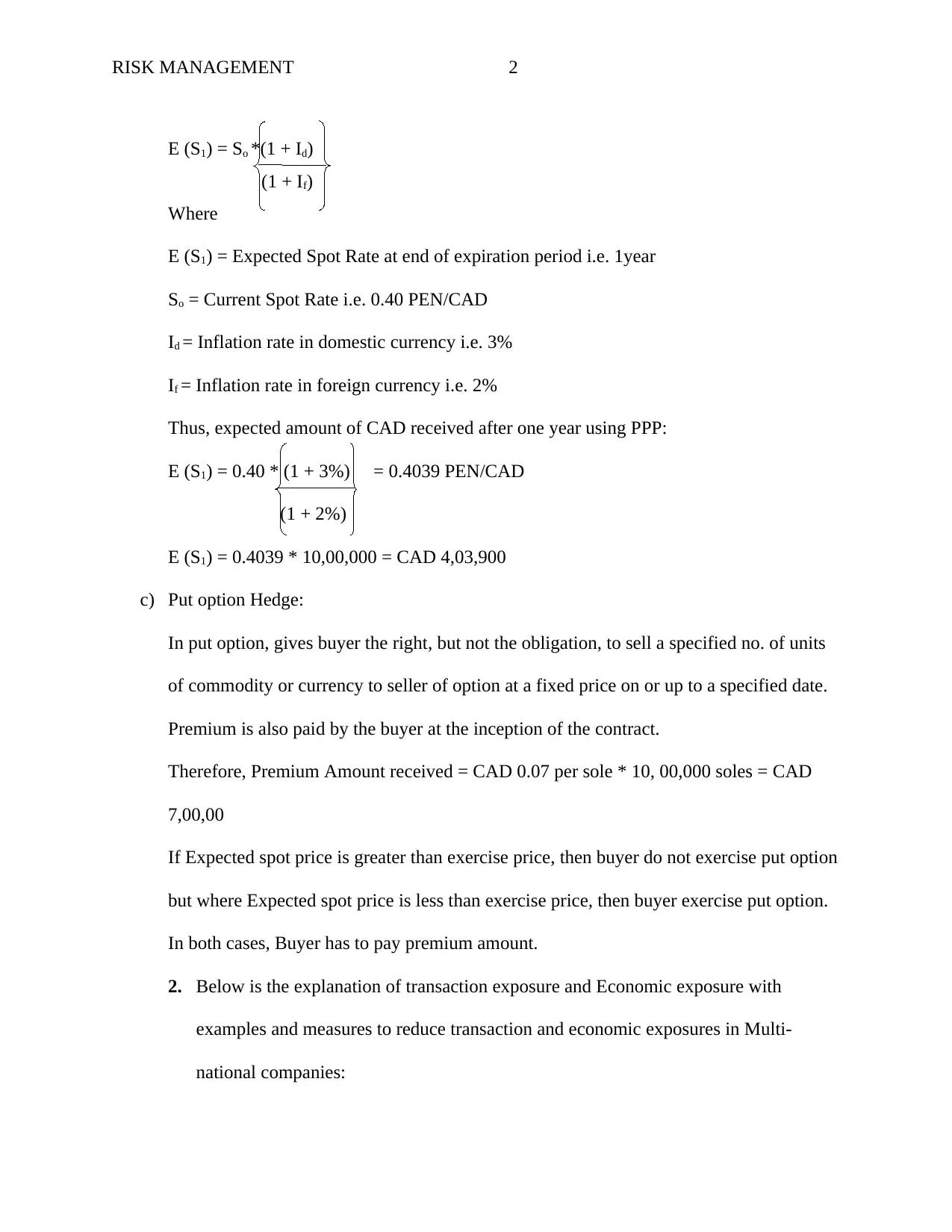
RISK MANAGEMENT 2
E (S1) = So *(1 + Id)
(1 + If)
Where
E (S1) = Expected Spot Rate at end of expiration period i.e. 1year
So = Current Spot Rate i.e. 0.40 PEN/CAD
Id = Inflation rate in domestic currency i.e. 3%
If = Inflation rate in foreign currency i.e. 2%
Thus, expected amount of CAD received after one year using PPP:
E (S1) = 0.40 * (1 + 3%) = 0.4039 PEN/CAD
(1 + 2%)
E (S1) = 0.4039 * 10,00,000 = CAD 4,03,900
c) Put option Hedge:
In put option, gives buyer the right, but not the obligation, to sell a specified no. of units
of commodity or currency to seller of option at a fixed price on or up to a specified date.
Premium is also paid by the buyer at the inception of the contract.
Therefore, Premium Amount received = CAD 0.07 per sole * 10, 00,000 soles = CAD
7,00,00
If Expected spot price is greater than exercise price, then buyer do not exercise put option
but where Expected spot price is less than exercise price, then buyer exercise put option.
In both cases, Buyer has to pay premium amount.
2. Below is the explanation of transaction exposure and Economic exposure with
examples and measures to reduce transaction and economic exposures in Multi-
national companies:
E (S1) = So *(1 + Id)
(1 + If)
Where
E (S1) = Expected Spot Rate at end of expiration period i.e. 1year
So = Current Spot Rate i.e. 0.40 PEN/CAD
Id = Inflation rate in domestic currency i.e. 3%
If = Inflation rate in foreign currency i.e. 2%
Thus, expected amount of CAD received after one year using PPP:
E (S1) = 0.40 * (1 + 3%) = 0.4039 PEN/CAD
(1 + 2%)
E (S1) = 0.4039 * 10,00,000 = CAD 4,03,900
c) Put option Hedge:
In put option, gives buyer the right, but not the obligation, to sell a specified no. of units
of commodity or currency to seller of option at a fixed price on or up to a specified date.
Premium is also paid by the buyer at the inception of the contract.
Therefore, Premium Amount received = CAD 0.07 per sole * 10, 00,000 soles = CAD
7,00,00
If Expected spot price is greater than exercise price, then buyer do not exercise put option
but where Expected spot price is less than exercise price, then buyer exercise put option.
In both cases, Buyer has to pay premium amount.
2. Below is the explanation of transaction exposure and Economic exposure with
examples and measures to reduce transaction and economic exposures in Multi-
national companies:
⊘ This is a preview!⊘
Do you want full access?
Subscribe today to unlock all pages.

Trusted by 1+ million students worldwide
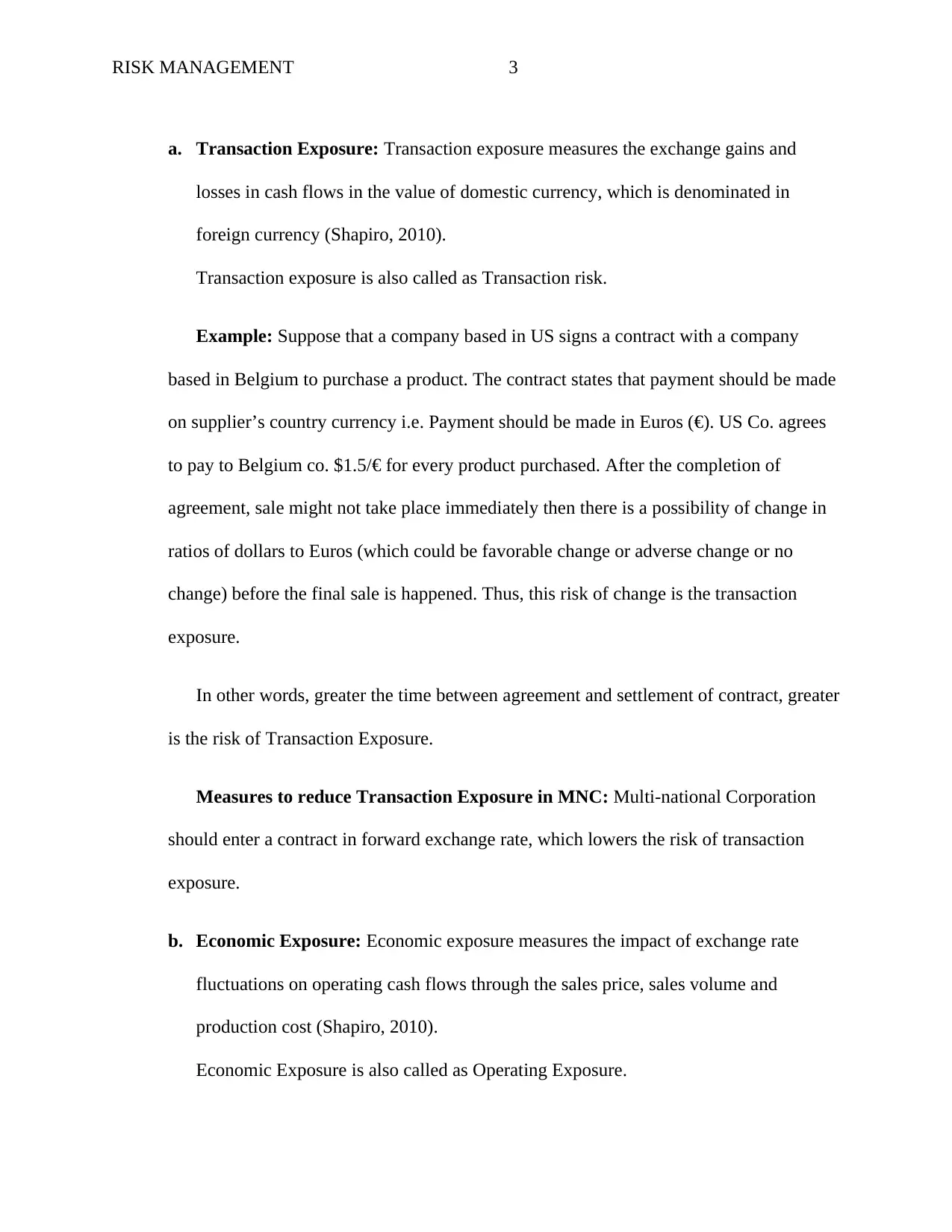
RISK MANAGEMENT 3
a. Transaction Exposure: Transaction exposure measures the exchange gains and
losses in cash flows in the value of domestic currency, which is denominated in
foreign currency (Shapiro, 2010).
Transaction exposure is also called as Transaction risk.
Example: Suppose that a company based in US signs a contract with a company
based in Belgium to purchase a product. The contract states that payment should be made
on supplier’s country currency i.e. Payment should be made in Euros (€). US Co. agrees
to pay to Belgium co. $1.5/€ for every product purchased. After the completion of
agreement, sale might not take place immediately then there is a possibility of change in
ratios of dollars to Euros (which could be favorable change or adverse change or no
change) before the final sale is happened. Thus, this risk of change is the transaction
exposure.
In other words, greater the time between agreement and settlement of contract, greater
is the risk of Transaction Exposure.
Measures to reduce Transaction Exposure in MNC: Multi-national Corporation
should enter a contract in forward exchange rate, which lowers the risk of transaction
exposure.
b. Economic Exposure: Economic exposure measures the impact of exchange rate
fluctuations on operating cash flows through the sales price, sales volume and
production cost (Shapiro, 2010).
Economic Exposure is also called as Operating Exposure.
a. Transaction Exposure: Transaction exposure measures the exchange gains and
losses in cash flows in the value of domestic currency, which is denominated in
foreign currency (Shapiro, 2010).
Transaction exposure is also called as Transaction risk.
Example: Suppose that a company based in US signs a contract with a company
based in Belgium to purchase a product. The contract states that payment should be made
on supplier’s country currency i.e. Payment should be made in Euros (€). US Co. agrees
to pay to Belgium co. $1.5/€ for every product purchased. After the completion of
agreement, sale might not take place immediately then there is a possibility of change in
ratios of dollars to Euros (which could be favorable change or adverse change or no
change) before the final sale is happened. Thus, this risk of change is the transaction
exposure.
In other words, greater the time between agreement and settlement of contract, greater
is the risk of Transaction Exposure.
Measures to reduce Transaction Exposure in MNC: Multi-national Corporation
should enter a contract in forward exchange rate, which lowers the risk of transaction
exposure.
b. Economic Exposure: Economic exposure measures the impact of exchange rate
fluctuations on operating cash flows through the sales price, sales volume and
production cost (Shapiro, 2010).
Economic Exposure is also called as Operating Exposure.
Paraphrase This Document
Need a fresh take? Get an instant paraphrase of this document with our AI Paraphraser
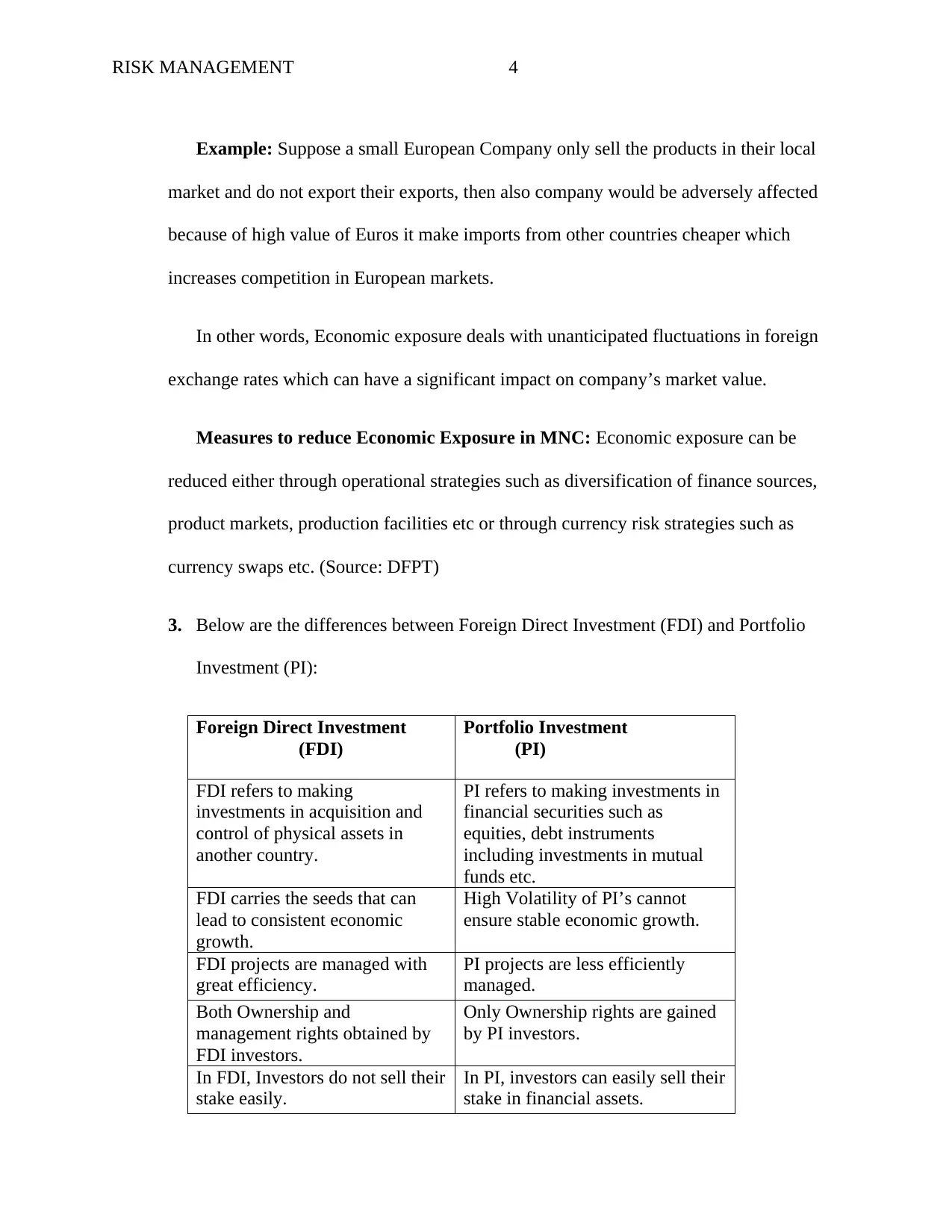
RISK MANAGEMENT 4
Example: Suppose a small European Company only sell the products in their local
market and do not export their exports, then also company would be adversely affected
because of high value of Euros it make imports from other countries cheaper which
increases competition in European markets.
In other words, Economic exposure deals with unanticipated fluctuations in foreign
exchange rates which can have a significant impact on company’s market value.
Measures to reduce Economic Exposure in MNC: Economic exposure can be
reduced either through operational strategies such as diversification of finance sources,
product markets, production facilities etc or through currency risk strategies such as
currency swaps etc. (Source: DFPT)
3. Below are the differences between Foreign Direct Investment (FDI) and Portfolio
Investment (PI):
Foreign Direct Investment
(FDI)
Portfolio Investment
(PI)
FDI refers to making
investments in acquisition and
control of physical assets in
another country.
PI refers to making investments in
financial securities such as
equities, debt instruments
including investments in mutual
funds etc.
FDI carries the seeds that can
lead to consistent economic
growth.
High Volatility of PI’s cannot
ensure stable economic growth.
FDI projects are managed with
great efficiency.
PI projects are less efficiently
managed.
Both Ownership and
management rights obtained by
FDI investors.
Only Ownership rights are gained
by PI investors.
In FDI, Investors do not sell their
stake easily.
In PI, investors can easily sell their
stake in financial assets.
Example: Suppose a small European Company only sell the products in their local
market and do not export their exports, then also company would be adversely affected
because of high value of Euros it make imports from other countries cheaper which
increases competition in European markets.
In other words, Economic exposure deals with unanticipated fluctuations in foreign
exchange rates which can have a significant impact on company’s market value.
Measures to reduce Economic Exposure in MNC: Economic exposure can be
reduced either through operational strategies such as diversification of finance sources,
product markets, production facilities etc or through currency risk strategies such as
currency swaps etc. (Source: DFPT)
3. Below are the differences between Foreign Direct Investment (FDI) and Portfolio
Investment (PI):
Foreign Direct Investment
(FDI)
Portfolio Investment
(PI)
FDI refers to making
investments in acquisition and
control of physical assets in
another country.
PI refers to making investments in
financial securities such as
equities, debt instruments
including investments in mutual
funds etc.
FDI carries the seeds that can
lead to consistent economic
growth.
High Volatility of PI’s cannot
ensure stable economic growth.
FDI projects are managed with
great efficiency.
PI projects are less efficiently
managed.
Both Ownership and
management rights obtained by
FDI investors.
Only Ownership rights are gained
by PI investors.
In FDI, Investors do not sell their
stake easily.
In PI, investors can easily sell their
stake in financial assets.
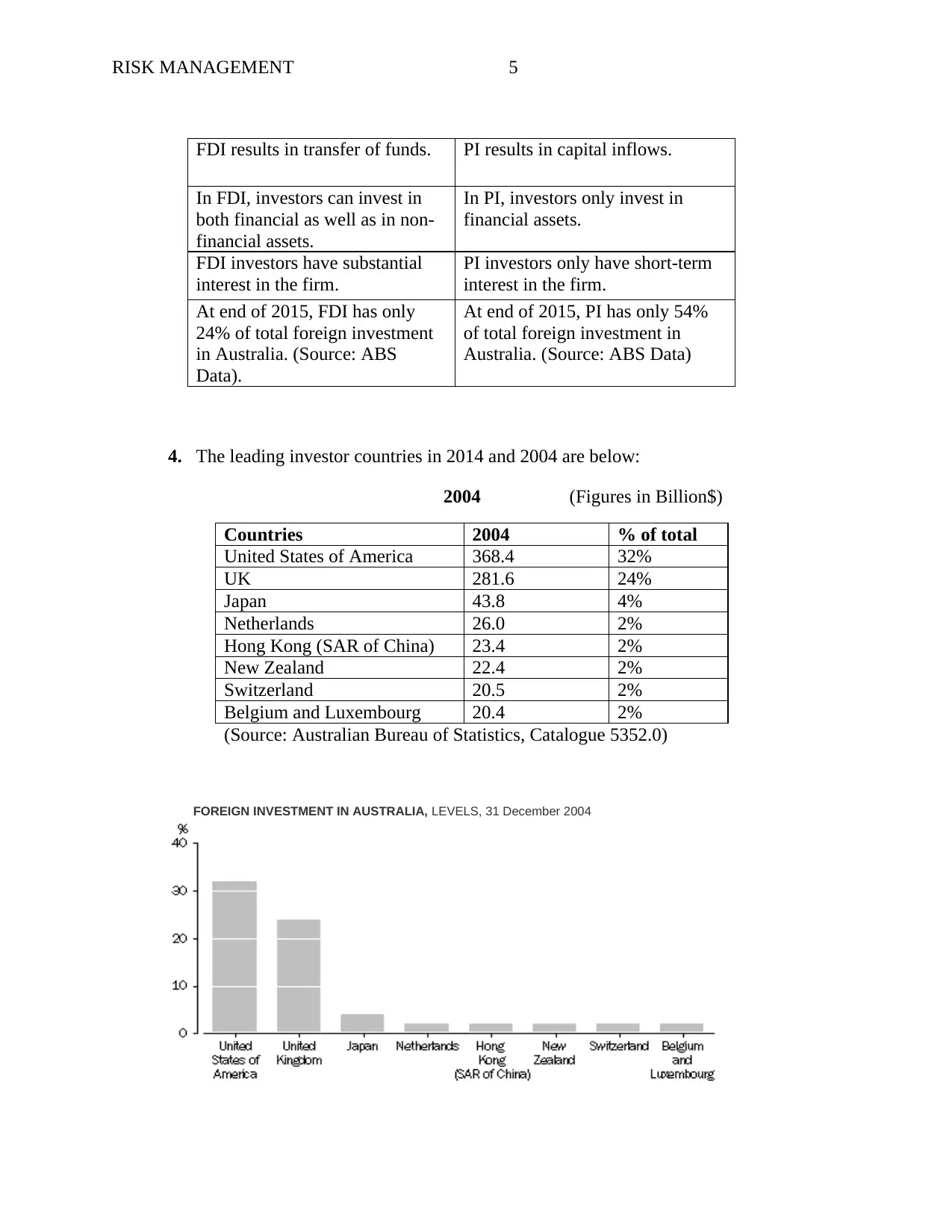
RISK MANAGEMENT 5
FDI results in transfer of funds. PI results in capital inflows.
In FDI, investors can invest in
both financial as well as in non-
financial assets.
In PI, investors only invest in
financial assets.
FDI investors have substantial
interest in the firm.
PI investors only have short-term
interest in the firm.
At end of 2015, FDI has only
24% of total foreign investment
in Australia. (Source: ABS
Data).
At end of 2015, PI has only 54%
of total foreign investment in
Australia. (Source: ABS Data)
4. The leading investor countries in 2014 and 2004 are below:
2004 (Figures in Billion$)
Countries 2004 % of total
United States of America 368.4 32%
UK 281.6 24%
Japan 43.8 4%
Netherlands 26.0 2%
Hong Kong (SAR of China) 23.4 2%
New Zealand 22.4 2%
Switzerland 20.5 2%
Belgium and Luxembourg 20.4 2%
(Source: Australian Bureau of Statistics, Catalogue 5352.0)
FOREIGN INVESTMENT IN AUSTRALIA, LEVELS, 31 December 2004
FDI results in transfer of funds. PI results in capital inflows.
In FDI, investors can invest in
both financial as well as in non-
financial assets.
In PI, investors only invest in
financial assets.
FDI investors have substantial
interest in the firm.
PI investors only have short-term
interest in the firm.
At end of 2015, FDI has only
24% of total foreign investment
in Australia. (Source: ABS
Data).
At end of 2015, PI has only 54%
of total foreign investment in
Australia. (Source: ABS Data)
4. The leading investor countries in 2014 and 2004 are below:
2004 (Figures in Billion$)
Countries 2004 % of total
United States of America 368.4 32%
UK 281.6 24%
Japan 43.8 4%
Netherlands 26.0 2%
Hong Kong (SAR of China) 23.4 2%
New Zealand 22.4 2%
Switzerland 20.5 2%
Belgium and Luxembourg 20.4 2%
(Source: Australian Bureau of Statistics, Catalogue 5352.0)
FOREIGN INVESTMENT IN AUSTRALIA, LEVELS, 31 December 2004
⊘ This is a preview!⊘
Do you want full access?
Subscribe today to unlock all pages.

Trusted by 1+ million students worldwide
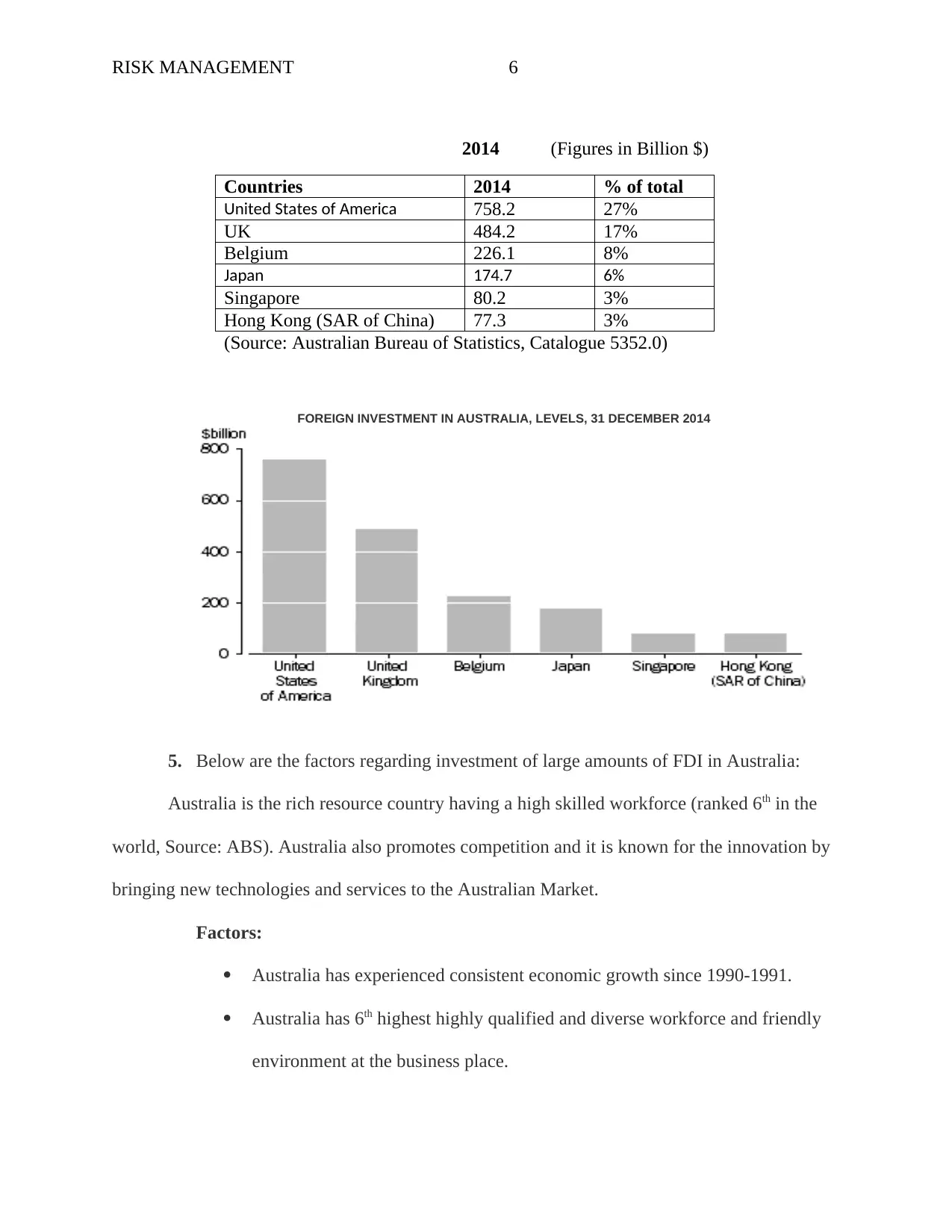
RISK MANAGEMENT 6
2014 (Figures in Billion $)
Countries 2014 % of total
United States of America 758.2 27%
UK 484.2 17%
Belgium 226.1 8%
Japan 174.7 6%
Singapore 80.2 3%
Hong Kong (SAR of China) 77.3 3%
(Source: Australian Bureau of Statistics, Catalogue 5352.0)
FOREIGN INVESTMENT IN AUSTRALIA, LEVELS, 31 DECEMBER 2014
5. Below are the factors regarding investment of large amounts of FDI in Australia:
Australia is the rich resource country having a high skilled workforce (ranked 6th in the
world, Source: ABS). Australia also promotes competition and it is known for the innovation by
bringing new technologies and services to the Australian Market.
Factors:
Australia has experienced consistent economic growth since 1990-1991.
Australia has 6th highest highly qualified and diverse workforce and friendly
environment at the business place.
2014 (Figures in Billion $)
Countries 2014 % of total
United States of America 758.2 27%
UK 484.2 17%
Belgium 226.1 8%
Japan 174.7 6%
Singapore 80.2 3%
Hong Kong (SAR of China) 77.3 3%
(Source: Australian Bureau of Statistics, Catalogue 5352.0)
FOREIGN INVESTMENT IN AUSTRALIA, LEVELS, 31 DECEMBER 2014
5. Below are the factors regarding investment of large amounts of FDI in Australia:
Australia is the rich resource country having a high skilled workforce (ranked 6th in the
world, Source: ABS). Australia also promotes competition and it is known for the innovation by
bringing new technologies and services to the Australian Market.
Factors:
Australia has experienced consistent economic growth since 1990-1991.
Australia has 6th highest highly qualified and diverse workforce and friendly
environment at the business place.
Paraphrase This Document
Need a fresh take? Get an instant paraphrase of this document with our AI Paraphraser
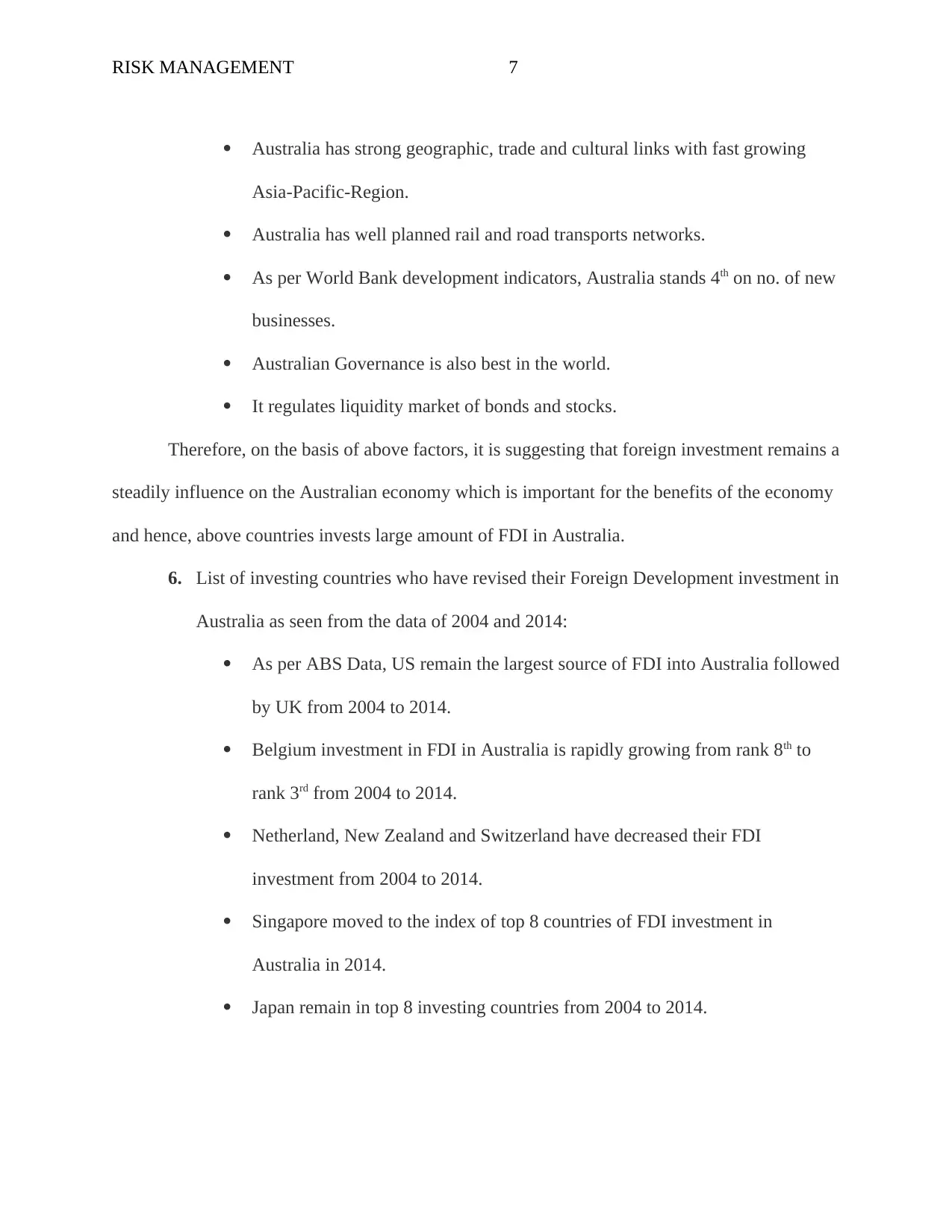
RISK MANAGEMENT 7
Australia has strong geographic, trade and cultural links with fast growing
Asia-Pacific-Region.
Australia has well planned rail and road transports networks.
As per World Bank development indicators, Australia stands 4th on no. of new
businesses.
Australian Governance is also best in the world.
It regulates liquidity market of bonds and stocks.
Therefore, on the basis of above factors, it is suggesting that foreign investment remains a
steadily influence on the Australian economy which is important for the benefits of the economy
and hence, above countries invests large amount of FDI in Australia.
6. List of investing countries who have revised their Foreign Development investment in
Australia as seen from the data of 2004 and 2014:
As per ABS Data, US remain the largest source of FDI into Australia followed
by UK from 2004 to 2014.
Belgium investment in FDI in Australia is rapidly growing from rank 8th to
rank 3rd from 2004 to 2014.
Netherland, New Zealand and Switzerland have decreased their FDI
investment from 2004 to 2014.
Singapore moved to the index of top 8 countries of FDI investment in
Australia in 2014.
Japan remain in top 8 investing countries from 2004 to 2014.
Australia has strong geographic, trade and cultural links with fast growing
Asia-Pacific-Region.
Australia has well planned rail and road transports networks.
As per World Bank development indicators, Australia stands 4th on no. of new
businesses.
Australian Governance is also best in the world.
It regulates liquidity market of bonds and stocks.
Therefore, on the basis of above factors, it is suggesting that foreign investment remains a
steadily influence on the Australian economy which is important for the benefits of the economy
and hence, above countries invests large amount of FDI in Australia.
6. List of investing countries who have revised their Foreign Development investment in
Australia as seen from the data of 2004 and 2014:
As per ABS Data, US remain the largest source of FDI into Australia followed
by UK from 2004 to 2014.
Belgium investment in FDI in Australia is rapidly growing from rank 8th to
rank 3rd from 2004 to 2014.
Netherland, New Zealand and Switzerland have decreased their FDI
investment from 2004 to 2014.
Singapore moved to the index of top 8 countries of FDI investment in
Australia in 2014.
Japan remain in top 8 investing countries from 2004 to 2014.

RISK MANAGEMENT 8
Reasons are as follows:
1) Positive Reasons:
FDI proved to be flexible during financial crisis, FDI opens up export opportunities
thereby increasing export performance also encourages macroeconomic environment and digital
innovation.
2) Negative Reasons:
In FDI, investing countries cannot easily have entered as well as exist from FDI and also
do not sell their FDI investment easily. FDI’s share is higher in countries with weaker credit
ratings.
Hence, from both positive and negative reasons, it is evidenced that FDI has appraised a
beneficial impact on economy of the world.
7. As per Kearney, 2006 survey, identifies that most cited reasons for increase in the
Foreign Direct Investment are due to availability of high quality investment targets
and competitive environment and also the geographical location of Australia also
makes it ideal for global business interactions.
Most investments cover 5 sectors these are: Software and IT services, business services,
financial services, chemical sector, manufacturing sector etc. In future forecast, it is seen that
majority of foreign investment approvals are for New Dwellings.
Thus, future expectations of 5 years over 2014 are that US, UK, Singapore and Japan will
remain in the largest source of FDI in Australia. Other major investing countries includes Hong
Kong and China. India is also entered the top 10 list of FDI index. This survey indicates Asian
Region are most interested in investing Australian FDI.
Reasons are as follows:
1) Positive Reasons:
FDI proved to be flexible during financial crisis, FDI opens up export opportunities
thereby increasing export performance also encourages macroeconomic environment and digital
innovation.
2) Negative Reasons:
In FDI, investing countries cannot easily have entered as well as exist from FDI and also
do not sell their FDI investment easily. FDI’s share is higher in countries with weaker credit
ratings.
Hence, from both positive and negative reasons, it is evidenced that FDI has appraised a
beneficial impact on economy of the world.
7. As per Kearney, 2006 survey, identifies that most cited reasons for increase in the
Foreign Direct Investment are due to availability of high quality investment targets
and competitive environment and also the geographical location of Australia also
makes it ideal for global business interactions.
Most investments cover 5 sectors these are: Software and IT services, business services,
financial services, chemical sector, manufacturing sector etc. In future forecast, it is seen that
majority of foreign investment approvals are for New Dwellings.
Thus, future expectations of 5 years over 2014 are that US, UK, Singapore and Japan will
remain in the largest source of FDI in Australia. Other major investing countries includes Hong
Kong and China. India is also entered the top 10 list of FDI index. This survey indicates Asian
Region are most interested in investing Australian FDI.
⊘ This is a preview!⊘
Do you want full access?
Subscribe today to unlock all pages.

Trusted by 1+ million students worldwide
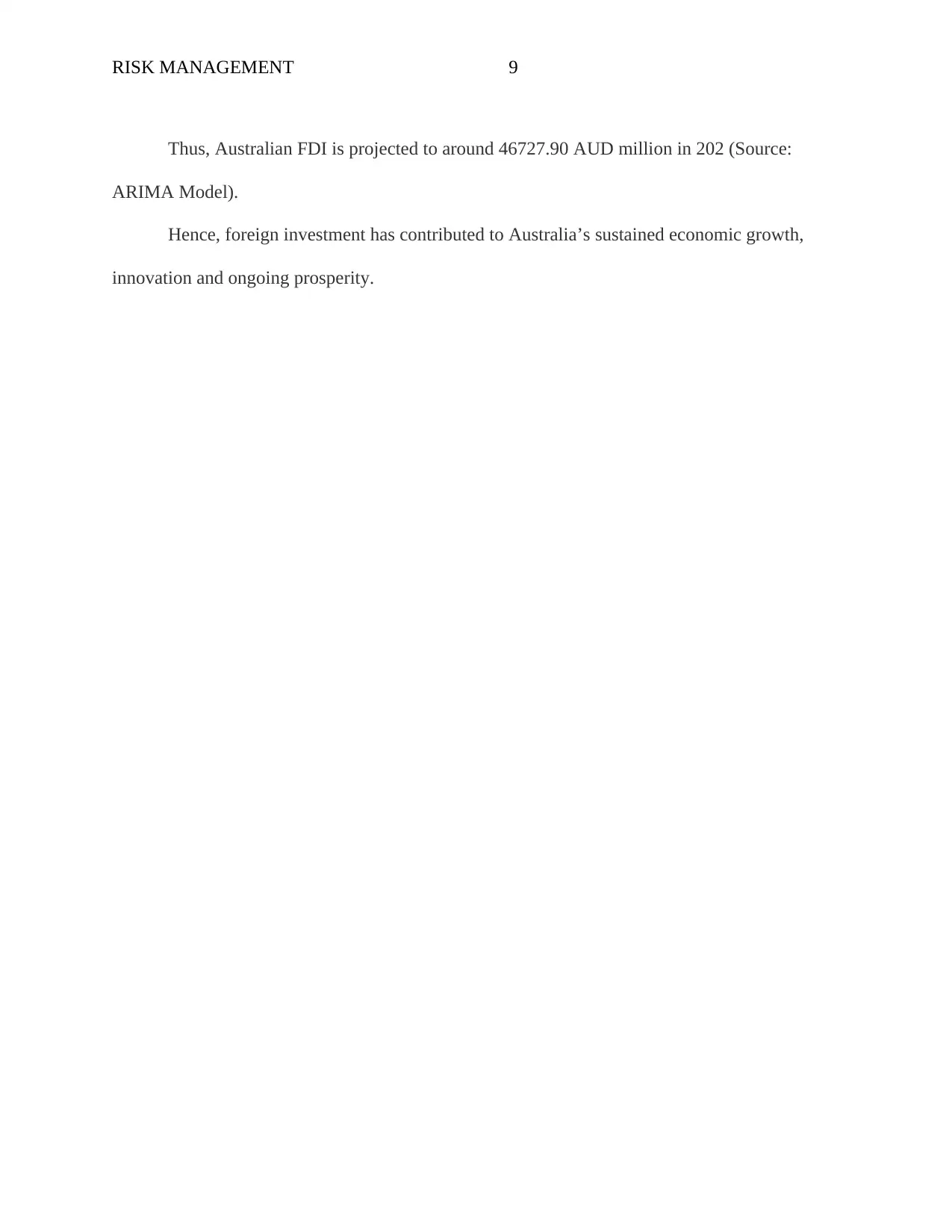
RISK MANAGEMENT 9
Thus, Australian FDI is projected to around 46727.90 AUD million in 202 (Source:
ARIMA Model).
Hence, foreign investment has contributed to Australia’s sustained economic growth,
innovation and ongoing prosperity.
Thus, Australian FDI is projected to around 46727.90 AUD million in 202 (Source:
ARIMA Model).
Hence, foreign investment has contributed to Australia’s sustained economic growth,
innovation and ongoing prosperity.
Paraphrase This Document
Need a fresh take? Get an instant paraphrase of this document with our AI Paraphraser

RISK MANAGEMENT 10
REFERENCES
Ahmad, Y, S., Cova, P. and Harrison, R. (2004) Foreign Direct Investment versus Portfolio
Investment: A global games approach. University of Wisconsin: Whitewater working paper.
Australian Bureau of Statistics. (2004)5352.0 – International Investment Position, Australia:
Supplementary Country Statistics. [Online]. Available from:
http://www.abs.gov.au/AUSSTATS/abs@.nsf/allprimarymainfeatures/568F68EE36081C32CA2
571C4007CCDE6?opendocument [Accessed 24 March 2017]
Australian Bureau of Statistics. (2014) 5352.0 – International Investment Position, Australia:
Supplementary Country Statistics. [Online]. Available from:
http://www.abs.gov.au/AUSSTATS/abs@.nsf/allprimarymainfeatures/011CD15D6E630B76CA
257FAF001A4235?opendocument [Accessed 24 March 2017]
Australian Trade and Investment commission. (2017). Guide to investing. [Online]. Available
from: http://www.austrade.gov.au/International/Invest/Investor-Guide [Accessed 24 March2017]
Clements, K, W. and Lan, Y. (2006) A new approach to Forecasting exchange rates. The
University of Western Australia: Australia.
Department of Foreign Affairs and Trade. (2017). Australia and foreign investment. [Online].
Available from: http://dfat.gov.au/trade/topics/investment/Pages/australia-and-foreign-
investment.aspx [Accessed 24 March 2017]
REFERENCES
Ahmad, Y, S., Cova, P. and Harrison, R. (2004) Foreign Direct Investment versus Portfolio
Investment: A global games approach. University of Wisconsin: Whitewater working paper.
Australian Bureau of Statistics. (2004)5352.0 – International Investment Position, Australia:
Supplementary Country Statistics. [Online]. Available from:
http://www.abs.gov.au/AUSSTATS/abs@.nsf/allprimarymainfeatures/568F68EE36081C32CA2
571C4007CCDE6?opendocument [Accessed 24 March 2017]
Australian Bureau of Statistics. (2014) 5352.0 – International Investment Position, Australia:
Supplementary Country Statistics. [Online]. Available from:
http://www.abs.gov.au/AUSSTATS/abs@.nsf/allprimarymainfeatures/011CD15D6E630B76CA
257FAF001A4235?opendocument [Accessed 24 March 2017]
Australian Trade and Investment commission. (2017). Guide to investing. [Online]. Available
from: http://www.austrade.gov.au/International/Invest/Investor-Guide [Accessed 24 March2017]
Clements, K, W. and Lan, Y. (2006) A new approach to Forecasting exchange rates. The
University of Western Australia: Australia.
Department of Foreign Affairs and Trade. (2017). Australia and foreign investment. [Online].
Available from: http://dfat.gov.au/trade/topics/investment/Pages/australia-and-foreign-
investment.aspx [Accessed 24 March 2017]
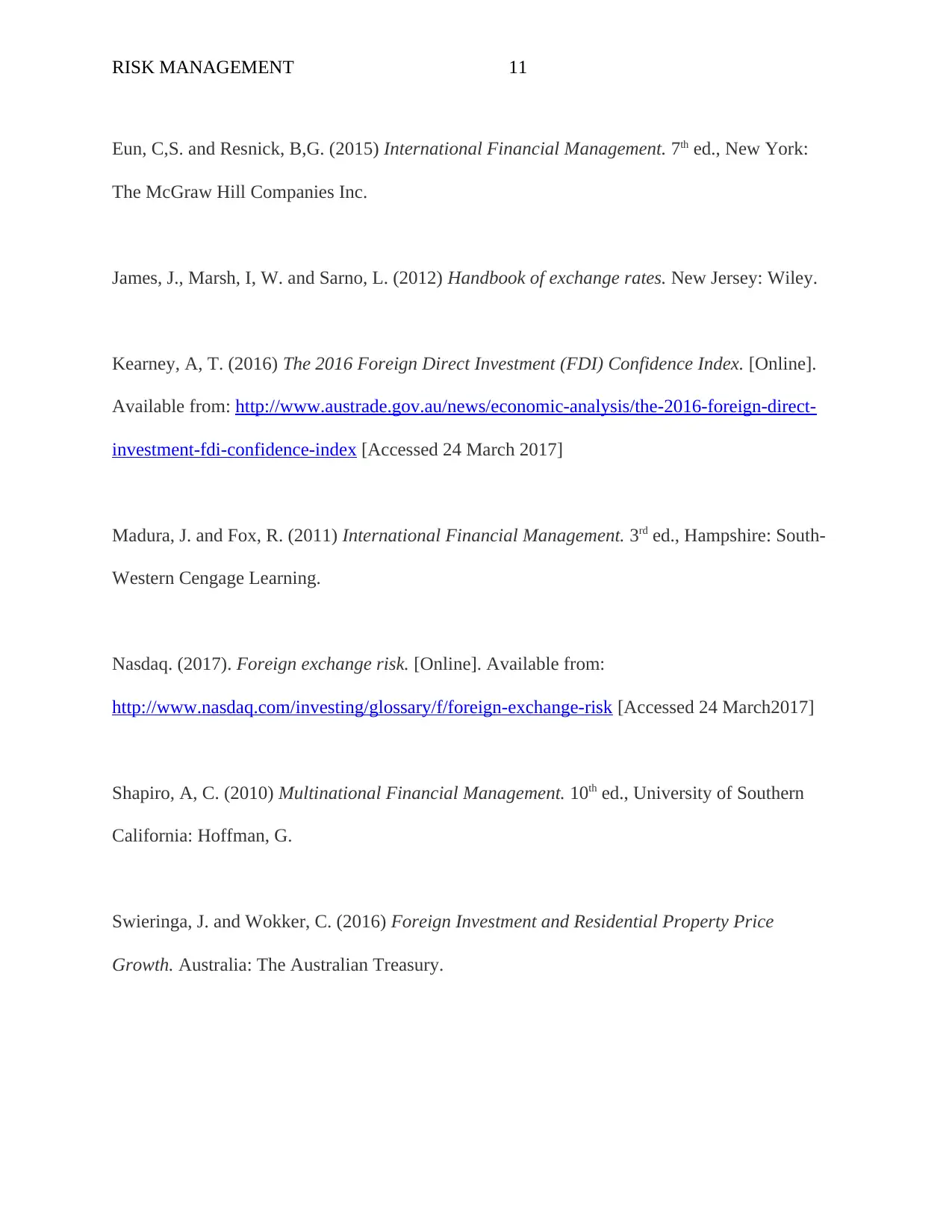
RISK MANAGEMENT 11
Eun, C,S. and Resnick, B,G. (2015) International Financial Management. 7th ed., New York:
The McGraw Hill Companies Inc.
James, J., Marsh, I, W. and Sarno, L. (2012) Handbook of exchange rates. New Jersey: Wiley.
Kearney, A, T. (2016) The 2016 Foreign Direct Investment (FDI) Confidence Index. [Online].
Available from: http://www.austrade.gov.au/news/economic-analysis/the-2016-foreign-direct-
investment-fdi-confidence-index [Accessed 24 March 2017]
Madura, J. and Fox, R. (2011) International Financial Management. 3rd ed., Hampshire: South-
Western Cengage Learning.
Nasdaq. (2017). Foreign exchange risk. [Online]. Available from:
http://www.nasdaq.com/investing/glossary/f/foreign-exchange-risk [Accessed 24 March2017]
Shapiro, A, C. (2010) Multinational Financial Management. 10th ed., University of Southern
California: Hoffman, G.
Swieringa, J. and Wokker, C. (2016) Foreign Investment and Residential Property Price
Growth. Australia: The Australian Treasury.
Eun, C,S. and Resnick, B,G. (2015) International Financial Management. 7th ed., New York:
The McGraw Hill Companies Inc.
James, J., Marsh, I, W. and Sarno, L. (2012) Handbook of exchange rates. New Jersey: Wiley.
Kearney, A, T. (2016) The 2016 Foreign Direct Investment (FDI) Confidence Index. [Online].
Available from: http://www.austrade.gov.au/news/economic-analysis/the-2016-foreign-direct-
investment-fdi-confidence-index [Accessed 24 March 2017]
Madura, J. and Fox, R. (2011) International Financial Management. 3rd ed., Hampshire: South-
Western Cengage Learning.
Nasdaq. (2017). Foreign exchange risk. [Online]. Available from:
http://www.nasdaq.com/investing/glossary/f/foreign-exchange-risk [Accessed 24 March2017]
Shapiro, A, C. (2010) Multinational Financial Management. 10th ed., University of Southern
California: Hoffman, G.
Swieringa, J. and Wokker, C. (2016) Foreign Investment and Residential Property Price
Growth. Australia: The Australian Treasury.
⊘ This is a preview!⊘
Do you want full access?
Subscribe today to unlock all pages.

Trusted by 1+ million students worldwide
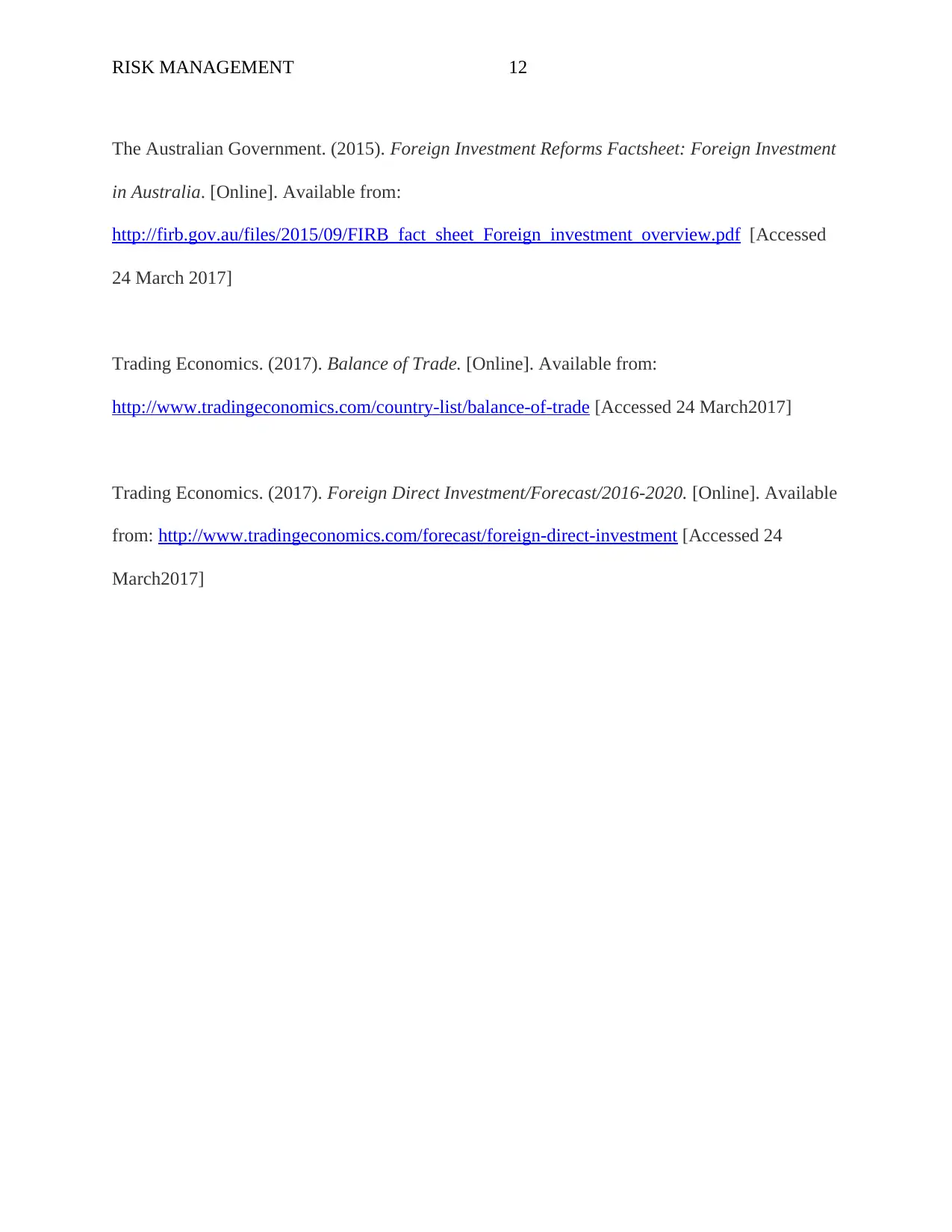
RISK MANAGEMENT 12
The Australian Government. (2015). Foreign Investment Reforms Factsheet: Foreign Investment
in Australia. [Online]. Available from:
http://firb.gov.au/files/2015/09/FIRB_fact_sheet_Foreign_investment_overview.pdf [Accessed
24 March 2017]
Trading Economics. (2017). Balance of Trade. [Online]. Available from:
http://www.tradingeconomics.com/country-list/balance-of-trade [Accessed 24 March2017]
Trading Economics. (2017). Foreign Direct Investment/Forecast/2016-2020. [Online]. Available
from: http://www.tradingeconomics.com/forecast/foreign-direct-investment [Accessed 24
March2017]
The Australian Government. (2015). Foreign Investment Reforms Factsheet: Foreign Investment
in Australia. [Online]. Available from:
http://firb.gov.au/files/2015/09/FIRB_fact_sheet_Foreign_investment_overview.pdf [Accessed
24 March 2017]
Trading Economics. (2017). Balance of Trade. [Online]. Available from:
http://www.tradingeconomics.com/country-list/balance-of-trade [Accessed 24 March2017]
Trading Economics. (2017). Foreign Direct Investment/Forecast/2016-2020. [Online]. Available
from: http://www.tradingeconomics.com/forecast/foreign-direct-investment [Accessed 24
March2017]
1 out of 13
Your All-in-One AI-Powered Toolkit for Academic Success.
+13062052269
info@desklib.com
Available 24*7 on WhatsApp / Email
![[object Object]](/_next/static/media/star-bottom.7253800d.svg)
Unlock your academic potential
© 2024 | Zucol Services PVT LTD | All rights reserved.
